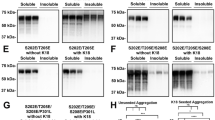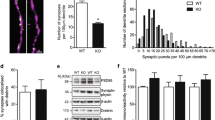Summary
Accumulation of paired helical filaments (PHF) in neurofibrillary tangles is a key neuropathological hallmark in Alzheimer's disease (AD). To date, PHF have been found primarily in humans. Cultured murine cholinergic neuroblastoma (S20Y) cells, following exposure to a serum-free medium or a differentiation medium, developed immunoreactivity to anti-PHF antibodies, and to the Alz-50 by immunocytochemical and immunoblot analyses. Electron microscopic examination revealed abundant fascicles of 10-nm filaments coursing tortuously amongst organelles, such as mitochondria, endoplasmic reticulum and dense-core vesicles, in perikarya and in neuritic extensions. However, subcellular structures identical or similar to PHF could not be found in these non-human cells. This convenient cell culture model may prove to be useful for studying certain aspects of the mechanisms underlying the abnormal cytoskeletal alterations which are characteristic of AD and related neurodegenerative disorders.
Similar content being viewed by others
References
Amano T, Richelson E, Nirenberg M (1972) Neurotransmitter synthesis by neuroblastoma clones. Proc Natl Acad Sci USA 69:258–263
Artlieb U, Krepler R, Wiche G (1985) Expression of microtubule-associates proteins, MAP-1 and MAP-2, in human neuroblastomas and differential diagnosis of immature neuroblasts. Lab Invest 53:684–691
Bancher C, Lassmann H, Budka H, Jellinger K, Grundke-Iqbal I, Iqbal K, Wiche G, Seitelberger F, Wisniewski HM (1989) An antigenic profile of Lewy bodies: immunocytochemical indication for protein phosphorylation and ubiquitination. J Neuropathol Exp Neurol 48:81–93
Bancher C, Brunner C, Lassmann H, Budka H, Jellinger K, Wiche G, Seitelberger F, Grundke-Iqbal I, Iqbal K, Wisniewski HM (1989) Accumulation of abnormally phosphorylated tau precedes the formation of neurofibrillary tangles in Alzheimer's disease. Brain Res 477:90–99
Blass JP, Baker AC, Sheu K-FR, Ko L, Black RS, Smith A (1989) Use of cultured skin fibroblasts in studies of Alzheimer's disease. In: Boller F, Katzman R, Rascol A, Signoret L, Christen Y (eds) Biological markers of Alzheimer's disease. Springer, Berlin Heidelberg New York, pp 153–162
Bottenstein JE (1983) Growth requirements of neural cells in vitro. Adv Cell Neurobiol 4:333–379
Conolly JA, Kalnins VI (1980) The distribution of tau and HMW microtubule-associated proteins in different cell types. Exp Cell Res 127:341–350
Cork LC, Powers RE, Selkoe DJ, Davies P, Geyer JJ, Price DL (1988) Neurofibrillary tangles and senile plaques in aged bears. J Neuropathol Exp Neurol 47:629–641
De Boni U, Crapper McLachlan DR (1985) Controlled induction of paired helical filaments of the Alzheimer type in cultured human neurons, by glutamate and aspartate. J Neurol Sci 68:105–118
Defossez A, Delacourte A (1987) Transformation of degenerating neurofibrils into amyloid substance in Alzheimer's disease: histochemical and immunohistochemical studies. J Neurol Sci 81:1–10
Galloway PG (1988) Antigenic characteristics of neurofibrillary tangles in progressive supranuclear palsy. Neurosci Lett 91:148–153
Galloway PG, Grundke-Iqbal I, Iqbal K, Perry G (1988) Lewy bodies contain epitopes both shared and distinct from Alzheimer neurofibrillary tangles. J Neuropathol Exp Neurol 47:654–663
Glenner GG, Eanes ED, Bladen HA, Linke RP, Termine JD (1974) β-Pleated sheet fibrils. A comparison of native amyloid with synthetic protein fibrils. J Histochem Cytochem 22:1141–1158
Goedert M, Wischik CM, Crowther RA, Walker JE, Klug A (1988) Cloning and sequencing of the cDNA encoding a core protein of the paired helical filament of Alzheimer disease: identification as the microtubule-associated protein tau. Proc Natl Acad Sci USA 85:4051–4055
Grundke-Iqbal I, Iqbal K, Quinlan M, Tung Y-C, Zaidi MS, Wisniewski HM (1986)_Microtubule-associated protein tau. A component of Alzheimer paired helical fimalents. J Biol Chem 261:6084–6089
Hsu S-M, Raine L, Fanger H (1981) Use of avidin-biotinperoxidase complex (ABC) in immunoperoxidase techniques: a comparison between ABC and unlabeled antibody (PAP) procedures. J Histochem Cytochem 29:577–580
Hyman BT, Van Hoesen GW, Wolozin BL, Davies P, Kromer LJ, Damasio AR (1988) Alz-50 antibody recognizes Alzheimer-related neuronal changes. An Neurol 23:371–379
Iqbal K, Grundke-Iqbal I, Smith AJ, Georgr L, Tung Y-C, Zaidi T (1989) Identification and localization of a τ peptide to paired helical filaments of Alzheimer disease. Proc Natl Acad Sci USA 86:5646–5650
Katzman R (1986) Alzheimer's disease. N Engl J Med 314:964–973
Kidd M (1963) Paired helical filaments in electron microscopy in Alzheimer's disease. Nature 197:192–193
Ko L, Koestner A, Wechsler W (1980) Morphological characterization of nitrosourea-induced glioma cell lines and clones. Acta Neuropathol 51:23–31
Ko L, Koestner A, Wechsler W (1980) Characterization of cell cycle and biological parameters of transplantable glioma cell lines and clones. Acta Neuropathol 51:107–111
Ko L, Sheu K-FR, Young O, Blass JP (1989) Expression of Alzheimer antigens in cultured mouse neuroblastoma cells. Trans Am Soc Neurochem 20:105 [A]
Ko L, Baker AC, Blass JP, Sheu K-FR (1990) Tissue culture models for the study of Alzheimer's disease. Neurobiol Aging 11:80 [A]
Ko L, Sheu K-FR, Young O, Thaler H, Blass JP (1990) Expression in cultured human neuroblastoma cells of epitopes associated with affected neurons in Alzheimer's disease. Am J Pathol 136:867–879
Kondo J, Honda T, Mori H, Hamada Y, Miura R, Ogawara M, Thara Y (1988) The carboxyl third of tau is tightly bound to paired helical filaments. Neuron 1:827–834
Kosik KS, Joachim CL, Selkoe DJ (1986) Microtubule-associated protein tau (τ) is a major antigenic component of paired helical filaments in Alzheimer disease. Proc Natl Acad Sci USA 83:4044–4048
Kosik KS, Orecchio LD, Binder L, Trojanowski JQ, Lee VMY, Lee G (1988) Epitopes that span the tau molecule are shared with paired helical filaments. Neuron 1:817–825
Ksiezak-Reding H, Davies P, Yen S-H (1988) Alz 50, a monoclonal antibody to Alzheimer's disease antigen, cross-reacts with tau proteins from bovine and normal human brain. J Biol Chem 263:7943–7947
Ksiezak-Reding H, Binder LI, Yen S-H (1988) Immunochemical and biochemical characterization of tau proteins in normal and Alzheimer's disease brains with Alz-50 and Tau 1. J Biol Chem 263:7948–7953
Langui D, Anderton BH, Brion JP, Ulrich J (1988) Effects of aluminium chloride on cultured cells from rat brain hemispheres. Brain Res 438:67–76
Love S, Saitoh T, Quijada S, Cole GM, Terry RD (1988) Alz-50, ubiquitin and tau immunoreactivity of neurofibrillary tangle, Pick bodies and Lewy bodies. J Neuropathol Exp Neurol 47:393–405
Love S, Burrola P, Terry RD, Wiley CA (1989) Immunoelectron microscopy of Alzheimer and Pick brain tissue labelled with the monoclonal antibody Alz-50. Neuropathol Appl Neurobiol 15:223–231
Masters CM, Multhaup G, Simms G, Pottgiesser J, Martins RN, Beyreuther K (1985) Neuronal origin of a cerebral amyloid: neurofibrillary tangles of Alzheimer's disease contain the same protein as the amyloid of plaque cores and blood vessels. EMBO J 4:2757–2763
Metuzals J, Robitaille Y, Houghton S, Gauthier S, Kang CY, Leblanc R (1988) Neuronal transformations in Alzheimer's disease. Cell Tissue Res 252:239–248
Nukina N, Kosik KS, Selkoe DJ (1988) The monoclonal antibody, Alz 50, recognizes tau proteins in Alzheimer's disease brain. Neurosci Lett 87:240–246
Papasozomenos SC (1989) Tau protein immunoreactivity in dementia of the Alzheimer type. II. Electron microscopy and pathogenetic implications. Effects of fixation on the morphology of the Alzheimer's abnormal filaments. Lab Invest 60:375–389
Pollock NJ, Binder LI, Mirra SS, Wood JG (1988) Alzheimer's disease: a model for study of cytoskeletal segregation as a determinant of neuronal form and function. In: Lasek RJ, Black MM, (eds) Intrinsic determinants of neuronal form and function. Alan R Liss, New York, pp 569–586
Probst A, Anderson BH, Ulrich J, Kohler R, Kahn J, Heitz PU (1983) Pick's disease: an immunocytochemical study of neuronal changes. Monoclonal antibodies show that Pick bodies share antigenic determinants with neurofibrillary tangles and neurofilaments. Acta Neuropathol 60:175–182
Roth M (1986) The association of clinical and neurological findings and its bearing on the classification and aetiology of Alzheimer's disease. Br Med Bull 42:42–50
Selkoe DJ (1987) Deciphering Alzheimer's disease: the pace quickens. Trends Neurosci 10:181–184
Selkoe DJ, Abraham CR (1986) Isolation of paired helical filaments and amyloid fibers from human brain. Methods Enzymol 134:388–404
Terry RD (1984) Alzheimer's disease. In: Scarpelli DG, Migaki G (eds) Comparative pathobiology of major age-related diseases: current status and research frontiers. Alan R. Liss, New York, pp 357–371
Terry RD, Katzman R (1983) Senile dementia of the Alzheimer type. Ann Neurol 14:497–506
Terry RD, Gonatas NK, Weiss M (1964) Ultrastructural studies in Alzheimer's disease presenile dementia. Am J Pathol 44:269–297
Towbin H, Staehelin T, Gordon J (1979) Electrophoretic transfer of proteins from polyacrylamide gels to nitrocellulose sheets: procedure and some applications. Proc Natl Acad Sci USA 76:4350–4354
Weber K, Osborn M (1975) Proteins and sodium dodecyl sulfate: molecular weight determination on polyacrylamide gels and related procedures. In: Neurath H, Hill RL (eds) The Proteins, 3rd edn. Academic Press, New York, pp 179–223
Wischik CM, Novak M, Thogersen HC, Edwards PC, Runswick MJ, Jakes R, Walker JE, Milstein C, Roth M, Klug A (1988) Isolation of a fragment of tau derived from the core of the paired helical filament of Alzheimer disease. Proc Natl Acad Sci USA 85:4506–4510
Wolozin BL, Davies P (1987) Alzheimer-related neuronal protein A68: specificity and distribution. Ann Neurol 22:521–526
Wolozin BL, Pruchinicki A, Dickson DW, Davies P (1986) A neuronal antigen in the brains of Alzheimer patients. Science 232:648–650
Yamamoto T, Hirano A (1986) A comparative study of modified Bielschowsky, Bodian and thioflavin S stains on Alzheimer's neurofibrillary tangles. Neuropathol Appl Neurobiol 12:3–9
Yen S-H, Crowe A, Dickson DW (1985) Monoclonal antibodies to Alzheimer neurofibrillary tangles 1. Identification of polypeptides. Am J Pathol 120:282–291
Yen S-H, Dickson DW, Crowe A, Butler M, Shelanski ML (1986) Alzheimer's neurofibrillary tangles contain unique epitopes and epitopes in common with the heat-stable microtubule associated proteins tau and MAP2. Am J Pathol 126:81–91
Author information
Authors and Affiliations
Additional information
Supported by grants from the Overbrook Foundation, the Will Rogers Institute, the Dr. I. Fund Foundation, the Winifred Masterson Burke Relief Foundation, the Alzheimer's Disease Research Program of the American Health Assistance Foundation and the National Institute of Aging (AG03853)
Rights and permissions
About this article
Cite this article
Ko, L., Sheu, K.F.R., Young, O. et al. Induction of epitopes associated with neurofibrillary tangles in clonal mouse neuroblastoma (S20Y) cells. Acta Neuropathol 81, 30–40 (1990). https://doi.org/10.1007/BF00662635
Received:
Revised:
Accepted:
Issue Date:
DOI: https://doi.org/10.1007/BF00662635




